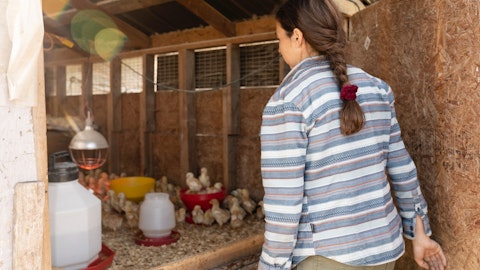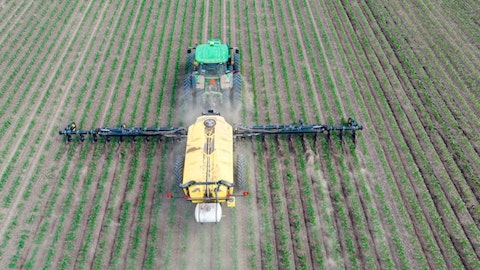Tractor Supply Company (NASDAQ:TSCO) Q3 2023 Earnings Call Transcript October 26, 2023
Tractor Supply Company beats earnings expectations. Reported EPS is $2.33, expectations were $2.27.
Operator: Good morning, ladies and gentlemen, and welcome to Tractor Supply Company’s Conference Call to discuss Third Quarter 2023 Results. At this time, all participants are in a listen-only mode. Later, we will conduct a question-and-answer session, and instructions will follow at that time. We ask that all participants limit themselves to one question and return to the queue for additional questions. Please note that the queue for our question-and-answer session did not open until the start of this call. Please be advised that reproduction of this call in whole or in part is not permitted without written authorization of Tractor Supply Company. And as a reminder this call is being recorded. I would now like to introduce your host for today’s call, Mrs. Mary Winn Pilkington, Senior Vice President of Investor and Public Relations for Tractor Supply Company. Mary Winn please go ahead.
Mary Winn Pilkington: Thank you, operator, and good morning everyone. Thanks for taking the time to join us today. On the call today for our prepared remarks are Hal Lawton, our CEO, and Kurt Barton our CFO. Seth Estep our EVP and Chief Merchandising Officer will join us for the Q&A session. Please note that we have made a supplemental slide presentation available on our website to accompany today’s earnings release. Now, let me reference the Safe Harbor Provisions under the Private Securities Litigation Reform Act of 1995. This call may contain certain forward-looking statements that are subject to significant risk and uncertainties, including the future operating and financial performance of the company. In many cases these risks and uncertainties are beyond our control.
Although the company believes the expectations reflected in its forward-looking statements are reasonable, it can give no assurance that such expectations or any of its forward-looking statements will prove to be correct and actual results may differ materially from expectations. Important risk factors that could cause actual results to differ materially from those reflected in the forward-looking statements are included at the end of the press release issued today and in the company’s filings with the Securities and Exchange Commission. The information contained in this call is accurate only as of the date discussed. Investors should not assume that statements will remain operative at a later time. Tractor Supply undertakes no obligation to update any information discussed in this call.
Given the number of people who want to participate, we respectfully ask that you please limit yourself to one question. If you have additional questions, please feel free to get back in the queue. I appreciate your cooperation. We will be available after the call for follow-up. Now, it is my pleasure to turn the call over to Hal.
Hal Lawton : Thanks Mary Winn and thank you to everyone for taking the time to join us this morning. To start, I would like to express my sincere thanks and appreciation to my fellow 50,000 Tractor Supply and Petsense team members. As always they lived our mission and values, delivered legendary service to our customers, did a great job being nimble in the quarter, and continued to deliver against our strategic initiatives. At Tractor Supply the underlying health of our business remains strong. We continue to achieve substantial market share gains. Our customer trends and customer engagement are robust and our Life Out Here strategic initiatives remain on track. Entering the third quarter, we had a sharp focus on the impact of the evolving macro environment and the impact of that environment on our customers retail spending patterns.
Despite this view, our quarter was more challenging than we initially expected. The primary drivers of our under performance were less than ideal weather conditions, as well as our customers continuing to be discerning with their spending. On the weather impact for the quarter, as we shared in our July earnings call, we anticipated that our compares would ease through the quarter as we were lapping one of the worst droughts in a decade. We were not assuming a significant benefit from the weather, but rather that it would not continue to be a drag on our performance. In fact, it was a drag. We estimate that the unfavorable weather conditions in the third quarter contributed more than one point of comp to our sales shortfall compared to our expectations.
While we never like to call out the adverse impacts of the weather on our business, there is no doubt that the challenging conditions continued to weigh on our sales this year as it relates to weather. In Q3 we had extreme heat and drought in Texa-homa and to a lesser degree the Midwest, and also we had excessive rainfall and the absence of cool weather in other areas like the Northeast. As an example, Texa-homa which makes up a little over 15% of our sales, we saw extreme temperatures and dryness there for most of the quarter. In fact, in Austin, Texas, as an example, there were 44 consecutive days of temperatures over 100 degrees in the third quarter. And for perspective, this was twice as many as Q3 of last year. Additionally, last year in the third quarter, we benefited from both the emergency response from Hurricane Ian and a shift to cooler fall temperatures in the last few weeks of the quarter in some of our markets.
This year, we did not have these events working in our favor. In the quarter, the emergency response from Hurricane Idalia was much smaller than the prior year. And a wave of summer-like temperatures continued into September, and in fact, even now into late October. Turning to the macro environment. As we shared last quarter, we believe that due to the cumulative effects of many factors, our customers are showing signs of strain. Examples of these factors include inflation, higher credit card balances, and the resumption of school loan payments. Additionally, consumers continue to shift their spending from goods to services, reverting back to pre-pandemic levels. In the context of this shift though, we believe that they remain more committed to the out-here lifestyle, and that our business is stickier than more discretionary components of retail.
But nonetheless, to some degree, we’ve been affected by this shift. Now, turning to the numbers for the third quarter. The team delivered net sales growth of 4.3%, with a modest comparable sales decrease of 0.4%. Diluted earnings per share for the quarter were $2.33, an increase of 11% over the prior year. Now, let’s shift to some highlights for the quarter. Comp transactions were flat for the prior year, offset by an average ticket decline of 0.3%. The average ticket performance was driven by a decline in units per transaction, with average unit retail remaining relatively strong. July was our best performing period of the quarter with positive comps. Both August and September comps negated given the seasonal trends I mentioned earlier. Importantly, our active customer counts are stable and growing, low single digits.
Also importantly, our reactivated, as well as new customer counts are also both positive and growing. E-commerce achieved sales growth in the high single digits, with strong conversion performance. Our Buy Online, Deliver from Store Program was up over 80%. And on a rolling 12-month basis, very notably, our digital sales have now surpassed $1 billion. Our consumable, usable, and edible products represented a meaningful portion of our business in the quarter. And these businesses continue to outperform our overall sales comp results, with continued strength in categories like dry dog food, cat food, poultry feed, lubricants, and shavings, just to name a few. CUE continues to be one of our structural advantages, and these categories and products represent the strength of our core business, and they are what drive footsteps into our store.
The gains in these categories were offset by declines in our late spring-summer seasonal product and big ticket categories, as well as softness in demand for those fall-winter product categories that usually begin to see some growth at the end of the quarter, due to the unseasonally warm weather. Big ticket performance remained under pressure, down in the mid-single digits, which was a slight improvement from the first half of the year. If I step back, overall though, we continue to gain share across categories online and in-store, and continue, as I said earlier, to see strong customer trends. On the customer front, our Neighbor’s Club membership base represented more than 77% of our sales for the quarter. We’re seeing continued favorable trends from our loyalty members.
Retention rates have never been higher, and our Neighbor’s Club members continue comping at a faster rate than our overall sales performance. And importantly, our high value customers again reached another record count in the quarter. In just over a year since launching Neighbor’s Club at Petsense, penetration of sales to our members now stands at over 65%, and we continue to benefit from the cross-shopping between the two brands, as we grow our share of wallets with these customers and focus on Pets Out Here in our collaboration between the two brands. A couple of trends that I mentioned last quarter did continue into this quarter, and those are, one, customers are continually increasing their usage of credit; and two, shoppers continue to seek out value, particularly in lower income customer cohorts.
Importantly, our overall customer satisfaction scores hit another new all-time high as we continue to invest in our team, and they continue to do a fantastic job providing best-in-class customer service, a hallmark of Tractor Supply. Through the third quarter, our customer satisfaction scores have increased and we experienced an improvement every week, year-over-year, since 2021. We’ve made significant progress in our Life Out Here Strategy. We now have just over 35% of our chain or 780 stores that are in the Project Fusion Layout, and our Garden Centers transformation is now active in over 420 locations. We continue to be very pleased with the strategic benefits and the financial returns of these store-level investments. Our Orscheln Farm and Home in the acquisition remains on track, with nearly 50 stores converted to the Tractor Supply brand.
And during the quarter, we completed the sale of the Orscheln Store Support Center and the Distribution Center as planned. Year-to-date we’ve opened 51 new Tractor Supply stores in 10 Petsense locations. Our team has done an excellent job executing our real estate project this year, and getting us back to a normalized cadence of new store openings, in spite of a tough backdrop in the broader construction market. During the quarter the real-estate team also successfully executed our first sale lease-back transaction, with the sale of 10 stores. In addition, the team has about 35 fee development sites in the works. I anticipate our real estate strategy will continue to be a source of increasing strength for Tractor Supply over the next few years.
Given our performance through the third quarter and our outlook for the fourth quarter, we’re updating our sales and earnings guidance for 2023. And Kurt will share some more details on our outlook later in the call. Before I hand it over to Kurt, if I just step back for a moment, if you told me in January of 2020 that we would nearly double our top line sales and earnings and deliver strong cash return to shareholders, while increasing our capital investment and growth initiative, and investing in team member wages, and investing in brand building, and doing all this through a global pandemic, major disruptions in global supply chains, rapidly changing consumer shifts, also rapidly escalating costs, including the highest consumer inflation in 40 years, it would have been hard to imagine, but that’s exactly what this team has delivered.
Over the last four years, we’ve added $7 billion in incremental sales. We’ve grown our market share significantly, and we’ve increased our earnings by 115% and returned over $3.2 billion of cash to shareholders. Our resilient needs-based business model has a proven history of growing through various economic conditions. Our customers and team members are dedicated to the Out Here lifestyle, and they prioritize it as it is their authentic lifestyle. Our customers over-index as homeowners, landowners, pet owners and animal owners. We believe that the softness we’re seeing is unique to transitory conditions in weather and consumer spending patterns. We continue to have a long-term structural macro trend that are favorable and sustainable. And as the market leader, we have substantial competitive advantages.
And with that, I’ll now turn the call over to Kurt.
Kurt Barton : Thank you, Hal, and hello to everyone on the call. There are three key observations about our business that build on Hal’s comments that I’d like to share before diving into the quarterly results. First, looking at the impact of weather. There are some years weather works to our favor and others where it clearly works against us. We’ve certainly tried to be transparent over the years as to the impact from the volatility related to weather, both in favorable and unfavorable events. No doubt 2023 will be a year where weather goes down as unfavorable for our business. From a warm January, a late start to the spring that never materialized over most of our markets, to a hot and dry summer across major markets like Texa-Homa and the Midwest, our seasonal businesses have been under pressure all year.
Second, our execution continues to be strong. Our Life Out Here initiatives are performing well and are positively impacting our results. Neighbor’s Club, Project Fusion and Garden Centers, pet and digital initiatives are all driving top line growth. Third, we view the softness in our customers’ retail spending to be unique to the macro challenges in the current environment. Our customer engagement is strong and our initiatives are driving positive results. We remain committed to investing for long-term growth, but we will be agile as we navigate the current environment. We are committed to continuing our track record of long-term value creation for our shareholders. Now, turning to our third quarter results. While our sales trends were below our expectations, the team managed the environment well, controlling what we can control.

We also remain steadfast in our commitment to being the dependable supplier for Life Out Here. Our third quarter top-line results were driven by strong and consistent CUE growth, offset by below trend seasonal performance and a weak summer demand and a lack of early fall seasonal sales, and discretionary big ticket sales remained under pressure. Our comparable store sales growth was solid in regions such as the southeast and the far west. The performance of these geo regions was offset by pressure in Texa-homa and the Midwest, where heat and drought trends added incremental pressure on consumer demand, as well as the warm start to the fall in the northern markets. Comparable transactions were flat for the quarter, with growth in our core year-round categories being offset by reduced demand for our seasonal categories.
We had a modest decline in the average comp ticket. Our average unit retail was up 3% to 4%. The benefit of the growth in our average unit retail was offset by the softness in big ticket and declines in seasonal categories, which run at a higher average ticket. Additionally, but to a lesser extent, we continue to experience softer sales and discretionary and impulse add-on items, putting pressure on the average units per transaction. Moving down our income statement, our gross profit increased 7.3% to $1.25 billion. Gross margin increased 101 basis points to 36.7% from 35.6% in the prior year’s third quarter. Gross margin was a highlight for the quarter as we continue to maintain strong product margin from our ongoing execution of everyday low price strategy.
At a time when the overall promotional environment across retail has picked up modestly, our large and robust membership of Neighbors Club offers us a great way to provide value. Our loyalty program allows us, together with our vendors, to strategically target value propositions for our customers. The gross margin rate increase was primarily attributable to lower transportation costs, driven by improvements in the global supply chain and efficiencies from our new distribution center in Ohio. Product mix pressured gross margin given the strength in CUE. This was somewhat offset by the margin improvement from lower big ticket sales, which carry a lower gross margin rate. As a percent of net sales, our selling, general and administrative expenses, including depreciation and amortization, increased 38 basis points to 26.7%.
The increase in SG&A as a percent of net sales was primarily attributable to our planned growth investments, which included higher depreciation and amortization and the onboarding of our new DC, along with some lost fixed cost leverage due to the decline in comparable store sales. Additionally, consistent with last quarter, higher medical claims also contributed to the increase in SG&A. We have made adjustments to our benefits program and will continue to do so. We don’t anticipate this to be a headwind in 2024. During the quarter we completed the planned sale lease back of 10 Tractor Supply store locations, benefiting SG&A by approximately 70 basis points, net of transaction and repair costs. Additionally, the increase in SG&A was partially offset by a one-time benefit to depreciation expense of approximately 35 basis points or $11 million pre-tax.
This benefit is attributed to a change in the useful lives of assets for certain remodeled stores, due to a reassessment of lease terms to better represent the economic profile of these investments. As I reflect on the SG&A performance overall, I would be remiss if I didn’t mention that our operations team did a great job scaling our core variable costs to our sales performance. Our distribution center teams achieved some of the best cut times, fill rates and overall productivity measures in years. And our store teams did a great job balancing store payroll to scale back, while also maintaining the right level of customer support and driving our best-in-class customer satisfaction scores. Overall, the team had strong execution and scaled our core variable costs well in this environment.
As an example, to further illustrate, nearly 85% of our core SG&A dollar growth year-over-year represents investments in our strategic growth initiatives. My appreciation goes out to the team for controlling what we could control. For the quarter, operating profit margin was 10%, a 62 basis point improvement from the prior year. Turning now to our balance sheet. Merchandise inventories were $2.8 billion at the end of the third quarter, flat to the prior year on a per store basis. We are managing it closely and continue to be very pleased with the quality and position of our inventory. Our in-stock rates are the best they’ve been in over two years. In addition, our inventory shrink improved year-over-year. With strong annualized cash flows, we continue to maintain a healthy balance sheet with a leverage ratio of around 2x.
Our long-term debt has no nearing maturities and it’s fixed at very attractive rates. Now, let me turn to our updated fiscal 2023 financial outlook. For the year, we now anticipate net sales in the range of $14.5 billion to $14.6 billion and comp store sales even with last year. Our full year operating margin rate is expected to be in the range of 10.1% to 10.2%, with net income of $1.1 billion to $1.11 billion. Diluted EPS is forecast to be $10 to $10.10. This includes a net after tax benefit of about $0.08 in Q4 for our remaining sale leaseback transactions this year. We continue to forecast anticipated capital expenditures for the year in the range of $800 million to $850 million or about $725 million to $775 million net of our capital needs for the fixed fee real estate strategy that we shared last quarter.
This higher level reflects the move to own development for select new store growth that will be funded through the sale of existing stores. It’s important to note that the proceeds from the sale of our own stores are expected to offset the incremental capital outlay under the development program. The combined transactions are expected to be relatively neutral to our cash position. Implied in our outlook is for fourth quarter comp store sales to be down low to mid-single digits. As Hal mentioned, we anticipate continued discerning consumer spending and unfavorable compares relating to weather as we experience the ongoing El Nino pattern, combined with the cycling of last year’s monumental winter storm, which drove 200 basis points of favorable impact on comps.
We anticipate continued strength in our core year-round categories, yet the softness in demand for seasonal and discretionary will continue to limit the top side on our performance. As a reminder, we are also lapping the 53rd week, which included an extra week of sales in the prior year, contributing approximately $225 million to top line sales and $0.16 of diluted earnings per share. As for retail price increases, our plans reflect a continued moderation of inflation. While still positive, we believe it will be modest. Our guidance reflects ongoing gross margin expansion year-over-year. We anticipate continued benefit from transportation and our new distribution center, along with some pressure from an unfavorable product mix. In the fourth quarter, we expect continued SG&A deleverage given our investments and the expected comparable store sales declines.
As we shared last quarter, for modeling purposes, the Orscheln stores will go into our comp calculation in 2024, based on when the store is converted to our point of sale system. Most stores converted to our point of sale during Q2 and Q3 of this year. As is customary, we will provide our guidance for 2024 at our fourth quarter earnings call. We’re still finalizing our outlook for sales, as there are a number of puts and takes to be considered. Let’s start with the fact that we’re a needs-based, demand-driven business, with a long history of positive comps. Additionally, as we see 2024 today, we expect we’ll have less benefit from inflation, but we’re 18 months into cycling big ticket softness. And the weather, hopefully, cannot be worse than it was this year.
But we do anticipate that the operating environment will continue to be challenging with a higher than normal degree of uncertainty and ongoing pressure on consumer confidence and household budgets. As we’ve shared over the last couple of years, we’ve always planned that 2023 would be our peak capital investment level. With that as a backdrop, we plan to prudently invest in our strategic priorities in 2024, with next year’s net capital spending in the 600’s, which will relieve some depreciation expense. We remain excited about the progress on our Life Out Here strategy and are very pleased with our initiatives. Our 10th distribution center will open during the second quarter of 2024. Much like our distribution center opening this year, this new DC benefits gross margin, but will pressure our SG&A as the facility ramps up.
The gross margin benefits typically lag the opening by about one quarter. Similar to 2023, we anticipate executing approximately 15 existing store sale leaseback transaction in 2024 to fund the own development new store program, and we anticipate the opening of 80 new Tractor Supply stores and 10 to 15 Petsense locations. Over our history, we have continually adapted to the operating environment around us. The needs-based, demand-driven characteristics of our product offerings support our ability to continue to be a winner in retail. We will remain agile and play offense. We will leverage our core competencies that have served us well, all while strengthening our capabilities and investing in our Life Out Here growth strategy. Now, I will turn the call over to Hal to wrap us up.
Hal Lawton : Thanks, Kurt. As the calendar shifts to the fall and winter season, our stores and online are ready for the change in typical Tractor Supply fashion. Our merchandising team has been working closely with our vendors on plans for the holiday season, with an emphasis on new products and innovation, and very notably with a focus on value. As the largest player in our sector, it is our obligation to be the advocate for value for our customers. And we are working hard to roll back the cost absorbed over the past two years. We will continue to be the destination for value and quality across our merchandising lineup. In key categories like heating and insulated apparel, our merchants have brought newness with compelling value, including exciting programs such as Columbia Performance Hunting Gear and our line of Grand Teton Pellet Stoves.
In our CUE categories, we have the right selection at the right price, with a focus on value, and are committed to being in stock as we continue to support our customers’ lifestyles. For example, you will see wood pallet stack outs in the majority of our stores in preparation for the winter season. And right now, our 400-plus garden centers are showcasing pumpkins, mums, and fall harvest decor. And this year we expanded our Halloween and harvest decor program with a great lineup to capitalize on our customers’ love for decorating their homes with on-trend seasonal indoor and outdoor decor, including a skeleton cow that was a TikTok viral sensation. Additionally, and particularly in light of the continued warmer weather, we continue to be the destination for our customers’ sporting goods, outdoor recreation, and outdoor wildlife interest, with products like our exclusive Royal Wing Bird Seed, Cannon Gun Safe, exclusive county line log splitters, and the Blackstone Griddle.
Earlier this week, we announced the addition of Yeti products to our lineup in our Fusion stores. We’re especially excited to collaborate with a well-regarded brand like Yeti that brings a long-standing reputation for quality and durability and aligns with our customers’ interest in camping, fishing, hunting and all outdoor activities. Our stores and garden centers will soon be filled with Christmas trees, wreaths and poinsettias. In addition to live goods, our customers can look forward to unique and different decor items, including our popular six-foot chicken lawn decorations and farm-themed holiday gingerbread kits. When it comes to gifts, we have compelling values and buys in every section of our store, from tools and grills to even fun, rural unique items like a 12-volt zero-turn ride-on toy lawnmower.
From a calendar perspective, it’s a good setup this year, with 31 days between Thanksgiving and Christmas. And Christmas falls on a Monday, so we anticipate a strong full weekend of sales prior to Christmas. We have a strong holiday season playbook with an exciting day-after-Thanksgiving day plan as well, with compelling offers programmed throughout the season. As we plan for the season though, we acknowledge there is a broader range of estimates for holiday consumer spending than we’ve seen over the last couple of years. As we enter the fourth quarter, we’re on track to achieve several milestones in our Life Out Here strategy. Notably, we anticipate ending the year with 40% of our store base in the Project Fusion format and nearly 500 garden centers, both significant milestones to initiatives that we began less than three years ago.
Our real estate pipeline is robust, with plans for 80 new Tractor Supply stores also in 2024. We’re piloting artificial intelligence in many functions in the business, including marketing, supply chain, and technology development. And one particular application that I’m very excited about is our generative AI knowledge tool that we call ‘Hey Gura.’ Using a proprietary AI engine that we built, we’re able to deliver knowledge directly to our team members through the headsets that each wear to augment their individual experience. Let me give you an example of this. One of the questions recently asked by a team member is, when do you switch from crumble feed to pellet for baby chicks? When asked, the Hey Gura app responded, ‘Typically chickens switch from crumble to pellet feed when they reach about 15 to 18 weeks of age, depending on breed and development.’ To-date, the results have been excellent.
Our team members are really embracing and excited about the technology, and it’s been a great value-add feature for our leading customer service. We have a long track record of growth and high expectations of performance. We view our current trends to these expectations as transitory and specific to the economic environment. This team is dialed in and understands the challenges. As we’re entering one of the busiest periods in retail, my thanks and sincere appreciation goes out to my fellow 50,000 Tractor Supply team members for their dedication to our mission and value. And with that, operator, we would now like to open the lines for questions.
Operator: [Operator Instructions] Our first question comes from the line of Scot Ciccarelli with Truist. Your line is now open.
See also 18 Highest Paying Countries for ESL Teachers and 10 Best Ways to Prevent Type 2 Diabetes.
Q&A Session
Follow Tractor Supply Co (NASDAQ:TSCO)
Follow Tractor Supply Co (NASDAQ:TSCO)
Scot Ciccarelli: Good morning, guys. Thanks for the question, Scot Ciccarelli. Given the decline in same-skew inflation and growing concerns, we may see a deflationary environment in pet food and feed. Can you help us understand, at least generally, how you’re thinking about the impact of inflation or deflation for ‘24, especially in your CUE categories?
Kurt Barton: Hey Scott. This is Kurt, and good morning. First, let me just start by saying, we still see an environment where there’s some net inflation year-over-year while modest. Inflation is clearly slowing, but not turning to deflation at this point. And specific to some of the categories, we are seeing, there’s areas this year where there’s year-over-year deflation, particularly areas like bird feed, livestock feed, corn based. Yeah, there’s some level of deflation. But there’s areas like you mentioned, where we’re still seeing some level of inflation still in the system, such as pet food. And then there’s most of our areas in our product categories, what I describe as they’ve hit a plateau. It’s stable, and we’re running pretty consistent.
And as that moves to the pipeline, very much consistent with our outlook for this year and beyond, was that we start to moderate down to a low single digit level of inflation in 2023. Too early to really say for 2024, but the general call would be that things begin to stabilize. Inflation, deflation is not as much of a factor in the average ticket that it’s been over the past few years, and it’s more stabilized and neutralish. And we’re certainly focused on it. This team works consistently in environments of change and inflation, deflation, have a history performing very well. Know that we’re monitoring it. I’ll be able to share more information on that in the fourth quarter call when we give our outlook for 2024.
Scot Ciccarelli: That’s really helpful. And then just for clarification, if we were to get same skew deflation, should we expect it to result in gross margin expansion? I think that used to be a general rule of thumb for you guys as we go back to pre-pandemic days. Thanks.
Kurt Barton: Yes, in general, our history has been that in a deflationary environment we’re able to leverage our scale, manage our retail pricing. It generally produces a benefit on the rate, just like inflation did over the last few years, put a bit of pressure on that rate. And we managed both environments very well, and historically it’s been as you described it.
Scot Ciccarelli: Very helpful. Thanks.
Operator: Thank you. The next question comes from the line of Steven Forbes with Guggenheim Partners. Your line is now open.
Steven Forbes: Good morning, Hal, Kurt, Seth. Maybe just a focus on capital spending plans for next year. I think you guys mentioned sort of in the $600 million range. I was curious Kurt, if you can maybe help us explain the year-over-year change, and if there’s any part of the strategic investment plan that you’re pulling back on for any particular reason.
Hal Lawton: Yeah. Hey, Steven. The biggest change, very much consistent with what we expect when we said peak years of 2022 and 2023, are those big investments in the distribution centers. We will open that second new distribution center next year in 2024, but a majority of that capital is in 2023. So on a net capital spend that we’re forecasting in the $725 to $775, if you back off of that into the $600’s, the biggest majority of that is supply chain. There’s other efficiencies in there, such as we continue on our investments in the stores, such as Fusion and Garden Centers to re-engineer and find efficiencies in our investments. Really excited about the two newest formats that we are rolling out in the stores that we’ve been able to re-engineer and drive costs out of our Garden Center, and that’s giving us even lower cost debt.
And then maybe the third thing would be the investments we made in 2023 on integration and remodeling the Orscheln stores. We’ll be rolling off of that. I think those three things are the biggest difference, but no shift in our strategic investments.
Steven Forbes: Thank you.
Operator: Thank you. The next question comes from the line of Peter Benedict with Baird. Your line is now open.




